- Publisher's Note
- Editorial
- Sixteen printmakers talk about their work
- The Imprinted Body
- A Chai with Vijay Bagodi
- The Wood Engravings of Haren Das
- A Physical Perception of Matter
- Feminine Worlds
- A Rich Theater of Visuality
- A Medley of Tradition
- Decontextualizing Reality
- Printmaking and/as the New Media
- Conversations with Woodcut
- Persistence of Anomaly
- Sakti Burman - In Paris with Love
- Lalu Prasad Shaw: The Journey Man
- Future Calculus
- A Note on Prints, Reproductions and Editions
- A Basic Glossary of Print Media
- The Art of Dissent: Ming Loyalist Art
- Vishnu: Hinduism's Blue-Skinned Savior at the Brooklyn Museum of Art
- Twelfth edition of Toronto International Art Fair
- Vintage Photographs of the Maharajas
- Göteborg International Biennial
- A Museum, a Retrospect & a Centenary for K.K. Hebbar:
- Recent and Retrospective: Showcase of Shuvaprasanna's Work
- "I Don't Paint To Live, I Live To Paint": Willem de Kooning
- Salvador Dali Retrospective: I am Delirious, Therefore I am
- To Be Just and To Be Fair
- Census of Senses: Investigating/Re-Producing Senses?
- Between Worlds: The Chittaprosad Retrospective
- Awesomely Artistic
- Random Strokes
- Counter Forces in The Printmaking Arena and how to Counter them
- Shift in focus in the Indian Art Market
- What Happened and What's Forthcoming
- Art Bengaluru
- Mumbai Art Sighting
- Musings from Chennai
- Art Events Kolkata
- Previews
- In the News
ART news & views
Sixteen printmakers talk about their work
Volume: 4 Issue No: 21 Month: 10 Year: 2011
Hard Talk
Contemporary Voices
Compiled from interviews by Waswo X. Waswo
In early August I asked a selection of younger artists to talk about their work via answering a short questionnaire. All of these artists have been, or currently are, highly involved with printmaking as a medium. The artists questioned were: B. Karuna, Dhruv Sonar, Dimple Shah, Jagadeesh T.R., Kurma Nadham, L.N. Bhuvaneshwari, Maripelly Praveen Goud, Prathap Modi, Moutushi, Neeraj Singh Khandka, Prabhakar Alok, Preeti Agrawal, Rajan Fulari, Rajesh Deb,  Soghra Khurasani, and Srikanta Paul. Below are selections from their varied responses.
Soghra Khurasani, and Srikanta Paul. Below are selections from their varied responses.
Dimple Shah: I primarily work with multi-plate photo-etching and silkscreen. The main reason for liking these two mediums is basically in these mediums there is more scope and possibility of working in detail and one can get results with a maximum of precision, unlike other mediums where the artist usually has to work within restrictions caused by the medium's own limitations. Etching and silkscreen give me the possibility to work in many colours...as many as 11 to 12...and I can also use photographic and graphic imagery with intricate detailing. In the last few years my work has been concerned with identifying 'Self' both on a macro and micro level: as an individual who is part of a social structure, a self who has to navigate through repercussions of political upheavals and develop perspicacity on related human issues, and on a personal level coping with emotive responses to alienation, insecurity and fear...the by-product of our 'modern' era. This duality of exploration is reflected in the concepts underlying my prints, paintings, as well as performance work.
L.N. Bhuvaneshwari: My imagery has often been 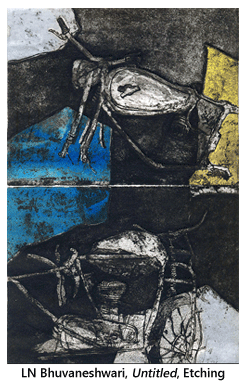 things like motorcycles and ceiling fans. Reality can never be completely reproduced, so I grew curious about what happens to the essence of an image when it is bent and squiggled by the human hand. The cement and metal plants of a factory, the automobiles...hard iron and jagged-edged reality gained strangely soft edges when isolated from their harsh surroundings. But my fascination with machines didn't end there. In some ways they seemed essential, in others, senseless. Reality became fraught with uncertainties, paradoxes, limited joys and infinite anguish, all speeding towards an unknown direction, a symbolic representation of human progress, destructibility, creative goodness and its inherent evil. Carving, etching and printing became to me a means of seeking harmony and integration
things like motorcycles and ceiling fans. Reality can never be completely reproduced, so I grew curious about what happens to the essence of an image when it is bent and squiggled by the human hand. The cement and metal plants of a factory, the automobiles...hard iron and jagged-edged reality gained strangely soft edges when isolated from their harsh surroundings. But my fascination with machines didn't end there. In some ways they seemed essential, in others, senseless. Reality became fraught with uncertainties, paradoxes, limited joys and infinite anguish, all speeding towards an unknown direction, a symbolic representation of human progress, destructibility, creative goodness and its inherent evil. Carving, etching and printing became to me a means of seeking harmony and integration
Maripelly Praveen Goud: I am more fascinated with science, technology and mathematics. I use science diagrams, schematic drawings, circuits, electrical elements and other images in my prints. I started working on portraits (the black portrait series) and gradually made them more conceptual. Always my works questioned “originality”. For example, one of my prints which is titled MODERNIZATION, tells how culture and tradition is slowly vanishing in villages and technology is reaching almost everywhere. This is partially personal experience because I myself migrated from a village to the cities.
Jagadeesh T.R.: The themes I work are about myself and the connections between village gossips and general issues. In this way my thought process is travelling back to what I have seen and what I have felt...mainly concentrated on what I would call "proverbs”. I am connecting myself in to those proverbs based on or by using my personal experiences.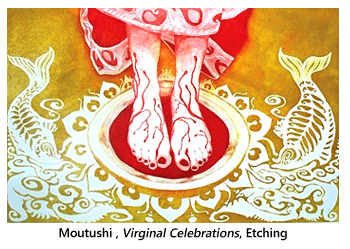 I am trying to show various incidents through my work. Woodcut printing technique supports my working process.
I am trying to show various incidents through my work. Woodcut printing technique supports my working process.
Moutushi: Growing up in a vibrant city steeped in cultural heritage, the Calcutta of my childhood inspired me to endlessly ruminate over the significance of historical anecdotes and metaphors. The city, which was once a paradise for writers, artists, musicians and scientists, has a long tradition of literary works - a gold-mine for books in literal terms. My art education therefore began from books and printed materials. An affinity for draughtsmanship guided my creative journey and prodded me to explore the medium of graphic arts. 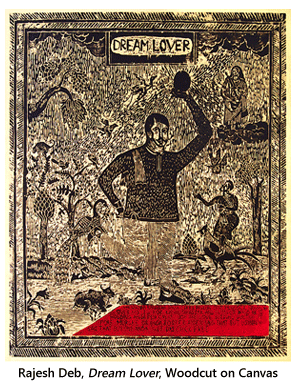 Content was invariably about the human existence, inundated by corporeal complexities that stem from living in a populous city where notions of privacy remain debatable.
Content was invariably about the human existence, inundated by corporeal complexities that stem from living in a populous city where notions of privacy remain debatable.
Rajesh Deb: I was born in Tripura, an extreme Northeast state of India, in the early 90s. I was attracted to the print medium. I was involved with a "little magazine movement" in my small town of Dharmanagar. I used to draw the cover pages of the magazines, and I used the rubber soles of shoes as block. This was like linocut. I had to do it because linoleum is unavailable in Tripura. This was the first freedom I enjoyed in the printmaking process. After my compulsory classroom teaching I embarked on woodcut, which to me is the extension of linoleum cut, or in my case, shoe-sole cut. Printmaking with woodcut is a very unique one to me and I enjoy it a lot, though sometimes I break the traditional process of printmaking.
B. Karuna: The difficult part of the woodcut medium is that if registration is not proper it's a big loss. 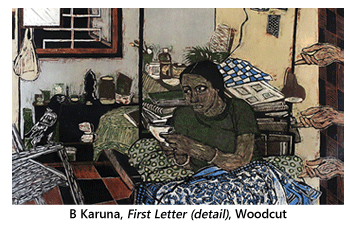 And in the south it takes lots of time to dry because of environmental changes. Sometimes it takes months in making a print because of changes in the humidity. The paper gets contracted and sometimes expanded, which of course gives rise to changes in registration. This is a problem, but it can be overcome. I like narrative imagery symbolically told. I depict mundane life, i.e. in my immediate surroundings. My work is a kind of diary written in a visual language. In a broader sphere it is "women's life".
And in the south it takes lots of time to dry because of environmental changes. Sometimes it takes months in making a print because of changes in the humidity. The paper gets contracted and sometimes expanded, which of course gives rise to changes in registration. This is a problem, but it can be overcome. I like narrative imagery symbolically told. I depict mundane life, i.e. in my immediate surroundings. My work is a kind of diary written in a visual language. In a broader sphere it is "women's life".
Preeti Agrawal: As an artist I try to understand all the positive and negative views of society. I'm inspired by feelings of the female in society:  their struggle, their images and their expressions. I try to read the conditions of women in the society. I have tried to collect all these feelings and emotions and present them through my art of printmaking. My portraits represent the emotions of a social woman. Basically I'm attracted to different aspects of women. I use these figures and visuals in my work. Each and every advertisement nowadays seems to have bikini-clad female figures, so I did work on this concept as my Polished Beauty series. I've done other work against violence and terrorism and thus I've tried to show the world united metaphorically.
their struggle, their images and their expressions. I try to read the conditions of women in the society. I have tried to collect all these feelings and emotions and present them through my art of printmaking. My portraits represent the emotions of a social woman. Basically I'm attracted to different aspects of women. I use these figures and visuals in my work. Each and every advertisement nowadays seems to have bikini-clad female figures, so I did work on this concept as my Polished Beauty series. I've done other work against violence and terrorism and thus I've tried to show the world united metaphorically.
Rajan Fulari: I have no specific method of working but eventually images evolve from adding and subtracting. There is always a preconceived idea and this leads to a specific mode in my printmaking. Basically, I work with human themes because human life interests me.  My works reflect a perception of the immediate world around me. They represent metascapes of mind. I bring the moral icons (Gandhi-Buddha-Christ) of our society and create awareness about social values. My works also attempt to fathom uncertainty and changes in time and space, by enigmatically depicting some relevant distinct forms. I always try to include social-political elements.
My works reflect a perception of the immediate world around me. They represent metascapes of mind. I bring the moral icons (Gandhi-Buddha-Christ) of our society and create awareness about social values. My works also attempt to fathom uncertainty and changes in time and space, by enigmatically depicting some relevant distinct forms. I always try to include social-political elements.
Neeraj Singh Khandka: I basically deal with the psychical factor. I think that our mind acts as the central point of our action and reaction, it works like the nucleus of an atom. While going through these actions and reactions a psychical play goes through our mind, the play of conscious and subconscious and unconscious. My idea is to have a keen observation on human nature and behaviour through this “triangle” of conscious, subconscious and unconscious. I prefer doing etching. I'm attracted to this medium because I like its mysterious and versatile effects. The rich black aquatint and bold and sensitive lines of etching provides a deep aesthetic feeling inside me. It is the vital and dynamic line of etching that attracts me. I go through a great joy while handling the sensational sensitivity of lines.
Soghra Khurasani: I work with woodcut, serigraphy, digital and etchings. As a printmaker, medium always plays a significant role in handling the concept of the work. I mostly express my ideas through the medium of woodcut, which I have continued since my bachelors.  From the time I entered masters the size format of my work has constantly increased. To further explore in this field I switched over to digital prints which suit the demand of my present concepts and where I can also experiment on them through various manual methods such as serigraphy and etchings. Woodcut has always been a joyful medium for me, but the main difficulty has been studio space. To continue working in large format a huge studio space is required. It also takes a lot of labour energy, and storing works and editions is also difficult. There are very few printmaking studios in India, so after graduation it is difficult for a lot of artists to continue printmaking.
From the time I entered masters the size format of my work has constantly increased. To further explore in this field I switched over to digital prints which suit the demand of my present concepts and where I can also experiment on them through various manual methods such as serigraphy and etchings. Woodcut has always been a joyful medium for me, but the main difficulty has been studio space. To continue working in large format a huge studio space is required. It also takes a lot of labour energy, and storing works and editions is also difficult. There are very few printmaking studios in India, so after graduation it is difficult for a lot of artists to continue printmaking.
Kurma Nadham: I'm from Andhra Pradesh, Visakhapatnam, and I came to Baroda for masters studies. When studied at Andhra University I did all mediums in printmaking. T. Sudhakar Reddy took great care and gave good direction in teaching students, and I was inspired a lot from Sudhakar Reddy and I learned techniques and drawing skills from him. In my first year I did all mediums in printmaking, and then, even after choosing printmaking as my discipline in second year, I continued doing work in all print mediums but was most attracted to etching and woodcut. Basically I like drawings. I try to visualize pen-line drawing when working on my etchings. I've continuously done iron engravings, etchings, aquatints. I've done woodcuts in my bachelors and masters, and I like wood carving, managing the registration, wood texture and all. I have been doing work in printmaking for nine years.
Dhruv Sonar: I love to work and experiment in all mediums in printmaking but all these hang about for a very short period of time except for etching. Etching is my favourite medium. Prints are nothing but an impression on a blank paper - the exact replica of what you have drawn. During the time involved in making a composition the first thing that comes into my mind is how the etching will be. In the process of making a plate, from the beginning to end, it really challenges you to learn from every new stroke you make in the plate. I etch my plates many times, and I grind, I scrape, and burnish till I get the required result. I think I get a grip into it. The plate listens to me and knows exactly what I want to create.
Etching is my favourite medium. Prints are nothing but an impression on a blank paper - the exact replica of what you have drawn. During the time involved in making a composition the first thing that comes into my mind is how the etching will be. In the process of making a plate, from the beginning to end, it really challenges you to learn from every new stroke you make in the plate. I etch my plates many times, and I grind, I scrape, and burnish till I get the required result. I think I get a grip into it. The plate listens to me and knows exactly what I want to create.
Preeti Agrawal: Whenever I plan to do any new work of woodcut medium I feel very happy to do it, I really enjoy it. After carving I enjoy doing the registration of wood with the paper and deciding the colouration. I'm interested in creating new textures in every new work. I use tracing papers, sand, leaves, beads….etc, to give textures. I experiment in all my new works with carving, composition, and the wood matrix's imagery. I get joy from every woodcut, and I never feel bored. Print medium is not like other mediums. Print medium has very many difficulties. When you decide to make a print you have to know about all the medium's techniques, and how to handle the medium's inherent rules. If any mistake occurs, as in registration or in mixing linseed oil with colours, it never turns out to be a good product of art.
Jagadeesh T.R.: I get lot of enjoyment in doing woodcut. I mostly like the carving process in different angles and different directions on wood through my sketch or layout. I like to do minor carving work with help of my tools and knives in this process of carving the wood. I print layer by layer to work on multi-colour printing. Sometimes the process will be light to dark and sometimes dark to light. I really enjoy the registration and spooning while taking multiple matrix editions. There are some difficulties while doing multi-colour printing, especially for huge size works, like hanging the number of editions for drying while printing. Spooning can be difficult. A printing press is not always used to apply pressure; sometimes the back of the paper is simply rubbed or pressed by hand with a spoon or with a simple paperweight. And inking is sometimes difficult on bigger printing areas. It's a little bit hard for a single person to handle the whole thing. But I enjoy both the difficulties and joy of carving and printing. I like to face the difficulties in the printing process. It's a challenging thing to me.
Prabhakar Alok: My work mostly shows dependency of human beings on machines. I hail from Bihar and as such my works are an expression of feelings of unrest and inequality, i.e the representation of the state's social conditions. Some of my works also show introspective figures in teeming backdrops. My figures are mostly self portraits and static on a background of bustling objects, figures and forms, i.e the background of urban reality. I like to think they are suffused with a wry, sardonic wit. I wish to address everything concerning human beings including their identities that today are moulded and manipulated by signs, words and visual language. Individuals can be seen in a complex contemporary world, facing the apathy of society in an unemotional urbanization.
Prathap Modi: 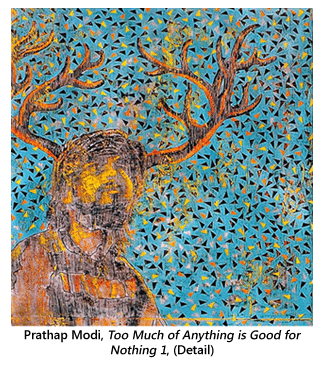 I feel in India people don't have knowledge about prints. We need to explain the whole concept to people. And printmakers here need to stick to their work. I've seen so many printmakers turn to painting. I am not saying don't do painting. But the same people can do print also. We need to motivate galleries. In some states they don't have graduate degrees in printmaking. If every college had a B.F.A for printmaking that would be ideal.
I feel in India people don't have knowledge about prints. We need to explain the whole concept to people. And printmakers here need to stick to their work. I've seen so many printmakers turn to painting. I am not saying don't do painting. But the same people can do print also. We need to motivate galleries. In some states they don't have graduate degrees in printmaking. If every college had a B.F.A for printmaking that would be ideal.
Dimple Shah: The popularity of printmaking in India today can only be increased when efforts are from all categories and sections of the art field. Firstly, more and more young artists like us have to be encouraged by senior printmakers and promoters of art. Usually it happen like this: a lot of national level camps happen very often, but you see the same group or set of so-called established senior printmaker called in for participation and the newcomers never come into the picture. The acceptance and chance for a young printmaker is important for securing a future of printmaking in India. Secondly, the acceptance of print as an individual medium from galleries, and promoting prints in mainstream art exhibitions is very much needed. In India we still don't see galleries coming up with print shows or thinking to market prints globally. There are lots of cases where printmakers have turned painters due to lack of exposure. The popularity of prints in India is still majorly just the reproduction of works by the Indian great masters in the form of silkscreens, and then marketing these at a lower price.
Srikanta Paul: It is very important to mention that people are hardly at all concerned or aware about printmaking techniques. Art lovers and buyers could not be convinced about my experiments which I do in my work, and also it is hard to convince them that I take only one unique print of any particular work. So they always bargain with me for my work and suggest to me to sell my work as a number of editioned prints. All peoples have their own ideology about their work. But it is very important for the future that educators should give their wise concern to this matter, and from the grassroots levels, i.e. at school level they should expose students to printmaking mediums from the back bencher to the front seater. In this concern art critics and galleries could play a major role to bring back the medium's gravity and prestige too.
Moutushi: What has been the response to my work? 'Ironical' is the expression that honestly comes to my mind. Always a meritorious student, a gold-medallist in printmaking from Faculty of Fine Arts, M.S. University Baroda, my work was hugely applauded by my teachers and peers alike in Santiniketan and Baroda. Bestowed with the prestigious Charles Wallace India Trust Award for Visual Arts and the Commonwealth fellowship for Arts & Crafts I was encouraged to pursue an Advanced MA programme in printmaking at London. However, the lukewarm response that I received from galleries in my own country was quite a paradox to the previous adulation. I realised that the term 'edition' in the practice of printmaking has now become its worst enemy. Art collectors were petrified that they would own a work of art that might also be adorning someone else's home! Our gallerists did not see fit to argue or explain the cause of printmaking and instead preferred not to host shows by printmakers. This set-back resulted in the ultimate abandoning of the medium by countless artists of my generation who sadly resorted to other mediums of visual art that conform to the 'sale tenet' of art galleries.
Dhruv Sonar: People are aware of paintings because they know this media from their childhood. A layman can guess what exactly a painting is because in the Indian education system it is a compulsory subject in primary classes. So from childhood people are getting interested in painting. And it is exactly opposite in the case of printmaking. Because in printmaking an individual must know about the tools, machinery and chemicals and these are not possible to learn at a very young age. Even I didn't know about the printmaking before getting involved in the fine arts. It is not like there is a fewer number of printmakers in India. But they all turned into painters because of bad response from the market.
Soghra Khursani: Some of my works were done in series of large woodcut prints. Brave Heart is dedicated to all the brave people of society. Soft appearance and strong courage makes up these hearts which constantly suffer from social threats. Tribute to Blood is a view of landscape overturning with rose buds and a dark red cloud filled with blood cells. Through this work I pay my tribute to all those anonymous lives who have suffered in massacre. Another work, Garland Tribute, again honours the anonymous heroic people who are wronged, and who become prey to the follies of human beings. Flow Between Territories is an outcome of the soreness of becoming just a game or maybe a scapegoat in the hands of society, a society that plays with identity and places us in whatever categories suit it, or maybe will lead to profits. The response to this work was amazing. Working in large format really worked with my concept. Now along with printmaking I'm also working in new media. As my work deals with public, society and religion, people were always supportive to expanding ideas, and I sort of collaborate with them in my work through talking with them. I still enjoy working in woodcut. I know I will further continue working in printmaking.